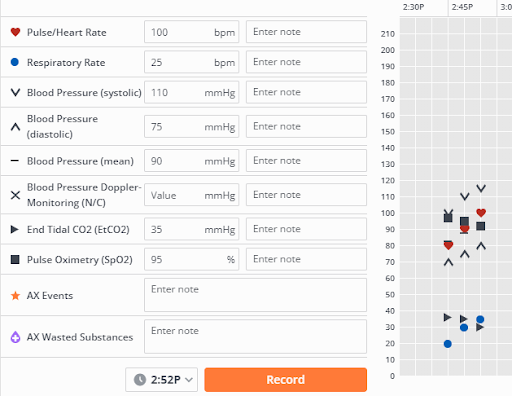In veterinary practice, we’re always looking for ways to enhance patient care, minimize mistakes, capture charges, and, perhaps most importantly, improve workflows in a meaningful way that positively impacts our staff.
Paper anesthesia sheets have been the norm for so long that we’re all accustomed to using them. But we all know they aren’t the best, most efficient, or even safest route for our patients.
For that reason, many hospitals have invented ad hoc digital versions using word-processing software. The downside: These digital versions are far from standardized, and they can be difficult to use at the point of care.
Here at Instinct, we’re all about creating digital tools that augment and streamline processes in veterinary hospitals. We got our start creating a digital treatment sheet platform that has streamlined one of the most paper-centric processes in veterinary practice. So it made sense to apply everything we’ve learned to developing a digital anesthesia monitoring tool as part of our full practice management system, Instinct EMR.
We’re pretty excited about it, and we think you will be, too. So let’s look at 5 reasons why you should go digital with anesthesia monitoring in Instinct EMR.
1. It can immediately reduce staff stress and improve patient care.
This is the #1 reason to use Instinct’s Anesthesia Mode (Ax Mode). It’s why we built it in the first place. When you’re not trying to fit your handwriting between tiny lines on a paper sheet or wrestling with formatting in a Word document, you get to spend less time being busy and more time doing vital work.
2. It’s built in a familiar format.
We get it—change is hard, especially when you’re already used to your current process, cumbersome as it may be.
That’s why we modeled Ax Mode after forms you’re already using. Familiarity dramatically reduces the learning curve, making it easier for teams to adapt.
We worked closely with veterinary anesthesiologists to keep Ax Mode familiar while still making major enhancements and improvements. The interface is much cleaner and more efficient than paper sheets, which can be messy and are easy to misplace, or digital sheets designed in a word processor, which can be time-consuming and headache-inducing.
3. It comes with built-in enhancements and improvements.
Create safe anesthetic protocols more efficiently with the same convenient tools in Instinct Treatment Plan.
Safety
Instinct’s built-in Plumb’s drug reference is an exceedingly popular feature, and it’s available in Ax Mode, too. As you create an individualized protocol for each patient, you can access the Plumb’s monograph to check key drug information before ordering.
Equally as popular as Plumb’s: the Instinct Dose Calculator, a built-in tool that means you don’t have to dig through a drawer or even pull out your phone. You can use the calculator to double-check a volume you’ve already calculated or calculate a volume from scratch based on your intended dose.
And as always, you can set up any medication with a calculator, and you can set up any calculator with Patient Safety Warnings. These safety ranges can be set per species by your admins and can follow protocols your medical team agrees on—even off-label dosing if indicated.

Convenience
Like the treatment sheets, Ax Mode leverages automated billing to seamlessly create invoices as you’re caring for your patient. Any billable product ordered in the Ax Mode treatment sheet will send charges to the Instinct Invoice as they’re completed.
You won’t have to spend an hour post-procedure calculating and entering charges anymore because it happened automatically while you were working on other more important things—like caring for your patient.
4. It’s fast but readable.
The medical field is notorious for hard-to-read handwriting. And it’s not surprising, considering how often we find ourselves having to write up notes on a clipboard or on our way to the next appointment.
However, writing on paper has a certain simplicity to it, and we’re not interested in complicating that. Instinct Ax Mode offers a different kind of simplicity: quick completion so you can get back to watching your patient.
Entering monitoring values is as simple as type > enter > tab and repeat. You don’t even have to click around to navigate from one parameter to another (but you can if you want to).
Results are also automatically graphed (we’re all about relevant automation), which means you save a step for every value you record. Scratching out an X or a dot might not seem all that time-consuming, but if you figure it takes an extra second or two for every value, you’ve saved minutes over the course of a procedure. Minutes you can spend watching the patient instead of your paper or screen.

Recording procedure events is just as quick. You can document Premed, Induction, Start/End, and Extubation times, each with a single click.
Make It Readable
Try as we might, handwritten records of any kind are never totally readable unless you’re someone blessed with unusually small and neat handwriting—and you do the writing for everyone in the hospital. Even then, if a mistake is made and has to be fixed, a paper sheet instantly becomes more cluttered.
Avoid this entirely when you go digital. You won’t have to squeeze cramped handwriting into small places, there won’t be a question about where the decimal point belongs, and even voided or discontinued treatments are conveniently recorded but hidden away. Everything can be documented, but you can change and update orders on the fly without impacting the professional and easy-to-interpret aesthetic.
5. It allows you to do things that are impossible with paper.
A monumental benefit of digital over paper: It’s always accessible wherever you are.
As a veterinary technician and anesthetic nurse, I’ve personally chased paper treatment sheets the length of the hospital, into the garbage, and more than once to the trunk of a doctor’s car. Paper feels easy, but it’s easy to lose, too. You can’t dispose of a digital treatment sheet or accidentally take it home for the weekend in your briefcase.
Paper can never be in more than one place at a time. But Instinct Ax Mode is accessible anywhere Instinct is—whether that’s at a hospital workstation or your computer at home.
This means other care teams, from the front desk to the post-op ward, can keep an eye on the procedure without having to yell through the OR door for updates.
So why is this all so important?
When your workflow involves fewer steps, you spend less time being busy and more time doing vital work.
Stepping away from your monitoring sheet (or computer screen) might seem counterintuitive, but it’s absolutely essential for safe anesthetic procedures, and we want to give you the time to do that. There are so many elements of patient status that can go overlooked if sole focus is placed on the record.
We all know equipment can’t tell you everything. It’s a great tool to quickly gather information we couldn’t obtain ourselves, but the scope of the average unit is limited to around 6 vital signs: temperature, ECG, respirometry, blood pressure, capnography, and pulse oximetry.
These are all essential to safe anesthetic procedures, but if we’re just staring at a paper, waiting for the timer to go off, other changes in patient status can easily be missed.
Physical monitoring involves things a monitor can’t tell us, and they’re just as important. When you step away from screens or papers, you have the opportunity to assess patient status in a different way:
- Cardiopulmonary: Pulse quality, auscultation, CRT/ MM, respiratory effort/chest wall movement
- Anesthetic depth and analgesic needs: Reflexes, eye position, jaw tone, muscle/sphincter tone, response to stimulus, patient movement
Going digital means higher quality records, fewer medical errors, and neater presentation.
But perhaps more importantly, going digital with Instinct’s Anesthesia Mode means an easy transition for your team, which translates to less stress, more time, and better patient care.
Curious whether Instinct Treatment Plan or Instinct EMR is right for your team? Request a demo.
